There are many health benefits of sauna bathing. Sauna bathing can improve your cardiovascular health, help you lose weight, improve your skin health, and boost your immune system. Everything about saunas and heat alteration in this article.
Many cultures have practiced some form of heat therapy for millennia. Saunas are a type of sweat lodges or heated rooms. Archaeologists have found evidence of saunas across the ancient world. There are similarities between the northern European sauna tradition and the sweat lodges used by native American tribes. No one knows where the first saunas were built, but the tradition is thought to originate somewhere in northern Europe around 2,000 BC. It has remained an important part of the culture to this day in Estonia, Latvia, and Russia, as well as in Finland.
Nowadays, there are two general types of sauna: traditional sauna and infrared sauna. Sauna purists in Finland demand that the word “sauna” should not be used in any other connection than the original sauna. Therefore an infrared sauna which has slightly different health benefits than traditional Finnish sauna should be called an infrared heat room. Heat alteration in any means possible including traditional Finnish sauna, sweat lodges, hammam, banya, hot baths, infrared or cold exposure in general makes our internal thermostat react in a way that is beneficial for health. In this section we will cover the biological mechanisms that underlie health benefits of rapid heat alteration.
Heat exposure
When the body is exposed to high heat whether that be in a sauna or while exercising, it is generating mild oxidative stress. The physiological response of the body is by turning on its various defense mechanisms. One of them includes heat shock proteins (HSPs), which are a family of proteins that get produced in response to heat stress and help to adapt to the stress through hormesis. They get released under environmental conditions of inflammation, heat stress, starvation, hypoxia, or even water deprivation.
Elevating body temperature above what’s normal is called hyperthermia. It usually starts at 37.5 °C. The average temperature for the human body is around 36-37°C (96.8-98.6°F). Deviations from this equilibrium cause thermal hormesis and trigger adaptive responses.
Heat Shock Proteins
Heat shock proteins (HSPs) are specific proteins that are made when cells are briefly exposed to temperatures above their normal growth temperature. The synthesis of HSPs is a universal phenomenon, occurring in all plant and animal species studied, including humans.
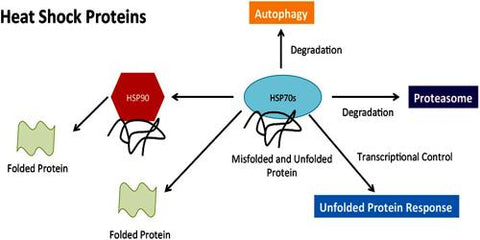
Image: Mechanisms of Heat Shock Proteins
Source: Nikesitch, N., & Ling, S. C. (2016). Molecular mechanisms in multiple myeloma drug resistance. Journal of Clinical Pathology 69 (2): 97–101.
Biochemical functions of the heat shock proteins (HSP) in the body:
- HSPs prevent the accumulation of free radicals (oxidative stress) and cellular damage
- HSPs repair damaged, misfolded proteins similar to autophagy (body’s primary mechanism through which the body recycles damaged cells)
- HSPs promote cellular antioxidant capacity with glutathione (body’s master antioxidant)
- HSPs are involved in macroautophagy and cellular turnover
- Hsp20 phosphorylation correlates with smooth muscle relaxation and has a significant role in cardiac myocyte (specialized heart muscle cells) function and skeletal muscle insulin response (blood sugar regulation)
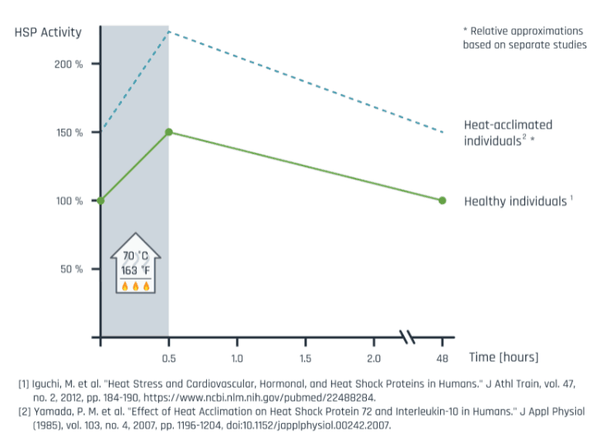
Greater benefits come from heat stress with elevated autophagy (for example while fasting) while including heat alteration through cold exposure (see later section on cold exposure). Mitochondrial autophagy protects against heat shock-induced apoptosis (programmed cell death to eliminate unwanted cells), which makes it even more important for stress adaptation. If you just sit in the sauna while blocking autophagy you may be causing more cellular damage than necessary. That’s why exposure to heat may be less stressful with elevated autophagy by including fasting and/or cold exposure.
To summarize, it is wise to go into the sauna in a fasted state or at least waiting 4-5 hours after eating before going into the sauna and avoid consumption of alcoholic beverages to maximize benefits of heat alteration. Sitting in the sauna with a full stomach not only feels uncomfortable, but it may cause harmful stress to the body.
Best way to activate heat shock proteins and take advantage of autophagy to the max:
- Fast for 16 hours
- Exercise for 20-30 mins
- Do heat alteration session
- 3x 15mins in the sauna
- 2 min cold exposure in-between
Nrf2 – an important biochemical pathway for heat stress
Nrf2 is a transcription factor commonly found in a cell’s cytoplasm. When Nrf2 is activated it goes into the nucleus to perform its main functions. The Nrf2 signaling pathway and its subsequent induction of cytoprotective (protection of cells from harmful agents) protein expression is the main cellular defense mechanism against oxidative and electrophilic stress. Therefore, interactions of Nrf2 with other signaling components regulate the efficiency of the cellular stress response. One of these is autophagy.
Heat exposure activates Nrf2, thereby upregulating a heat shock protein heme oxygenase-1 (HO-1), which is an enzyme that breaks down heme (pro-oxidant) to generate carbon monoxide (anti-inflammatory) and biliverdin and eventually bilirubin (antioxidant). This is a desired and protective effect on the body. The effect of HO-1 upregulation includes inhibition of the expression of several pro-inflammatory molecules involved in the pathophysiology of cardiovascular disease.
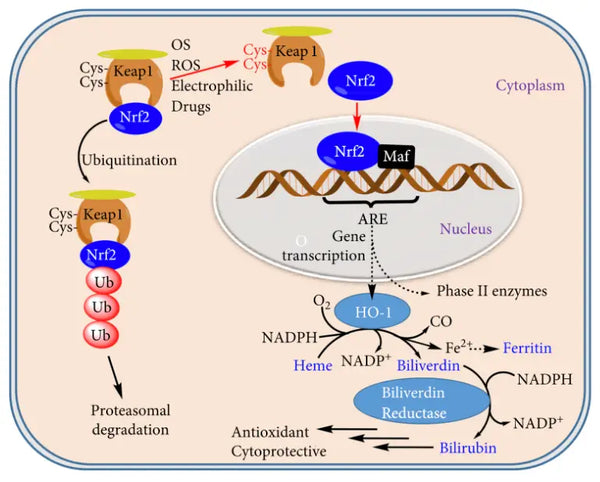
Image: The Nrf2-Keap1-HO-1 pathway.
Source: Otterbein, L. & Foresti, R. & Motterlini, R. (2016). Heme Oxygenase-1 and Carbon Monoxide in the Heart: The Balancing Act Between Danger Signaling and Pro-Survival. Circulation Research 118 (12): 1940–1959.
FOXO3 proteins & heat stress
FOXO3 proteins are members of the FOX family of transcriptional regulators. They play important roles in human lifespan and healthy aging. FOXO3 regulates genes that fight cellular aging (e.g. damage to DNA, proteins, and lipids & loss of stem cell function). FOXO3 also participates in autophagy.
When cells undergo heat stress, FOXO3 proteins form a complex with sirtuin 1 (SIRT1), which is an enzyme that influences aging and longevity via multiple molecular pathways. Sirtuins regulate a variety of metabolic processes, which include stress response, lifespan, insulin regulation, and lipids mobilization.
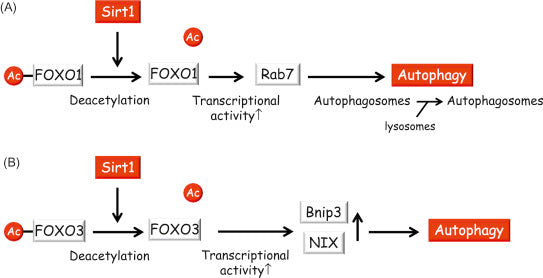
Physiological benefits of sauna and heat exposure
Intense short-term heat exposure elevates skin temperature and core body temperature and activates thermoregulatory pathways via the hypothalamus in the brain and central nervous system (CNS) leading to activation of the autonomic nervous system.
The activation of the sympathetic nervous system, hypothalamus-pituitary-adrenal (HPA) axis, and the renin-angiotensin-aldosterone system (RAS) lead to well-documented cardiovascular effects with increased heart rate, skin blood flow, cardiac output, and sweating.
Sweating caused by the heat evaporates from the skin surface and produces cooling that facilitates temperature homeostasis. Sauna therapy practices the body’s thermoregulatory trait of homeothermy, which is the physiological capability (of mammals and birds) to maintain a relatively constant core body temperature with minimal deviation from a set point.
When cells experience stress related to heat, they also activate heat shock proteins (HSP), which begin to regulate gene expression.
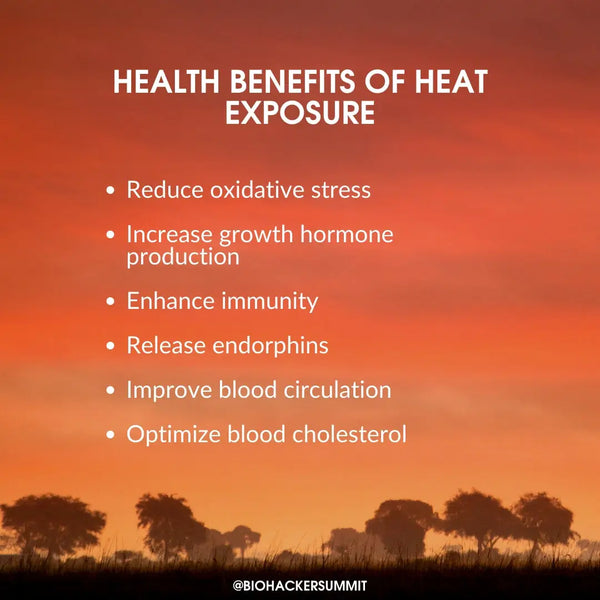
The benefits of this process include:
- Taking a sauna has been shown to improve cardiovascular functioning and lower the risk of heart disease.
- A link has been found between regular sauna baths (2–3 times per week) and a significantly lower risk of cardiac arrest (22%) and coronary heart disease. The more frequent and prolonged the sauna sessions, the greater the health benefit.
- Those who went to the sauna 4-7 times a week were 63% less likely to experience cardiac death and 50% less likely to die from cardiovascular disease compared to those who used it once a week. They were also associated with a 40% reduced risk of all-cause mortality.
- Saunas improve insulin sensitivity by increasing the expression of a glucose transporter called GLUT4 that helps to clear the bloodstream from sugar and direct it into muscles.
- Just 30-minutes of hyperthermic conditioning 3-times a week for twelve weeks has resulted in a 31% reduction in insulin and blood sugar levels. This can be useful for managing glycemic variability and control.
- Heat stress also releases massive amounts of growth hormone, which will inhibit protein breakdown. Growth hormone stays elevated for several hours after the sauna and it has incredible anti-catabolic effects that will prevent muscle breakdown and can promote additional fat burning.
- If you’re going for extended long fasts, then it might be a good idea to take a short sauna while being in the fasted state.
- Two 20-minute sauna sessions in 80–100 degrees Celsius (176 Fahrenheit) with a 30-minute cooling break in between may increase the production of growth hormone 2–5-fold (the hotter the temperature, the greater the growth hormone production)
- Two 1-hour sauna sessions a day at 80°C (176°F) dry heat for 7 days was shown to boost growth hormone by 16-fold on the third day.
- Heat strengthens the immune system and increases white blood cell count (WBC). It also flushes the lymph system from toxins and pathogens. See more detailed analysis in the next section.
- What is interesting is that a single Finnish sauna bathing session is more effective on athletes than non-athletes: “...increased number of white blood cells, lymphocyte, neutrophil ,and basophil counts was reported in the white blood cell profile. Higher increments in leukocyte and monocyte after the sauna bathing session were recorded in the group of athletes compared to untrained subjects. The obtained results indicated that sauna bathing stimulated the immune system to a higher degree in the group of athletes compared to the untrained subjects.”
- Hyperthermic conditioning (e.g. sauna) lowers the risk of dementia and Alzheimer’s disease (study in middle-aged Finnish men).
The conclusion from the 2018 meta-analysis on the health benefits of sauna:
Regular infrared and/or Finnish sauna bathing has the potential to provide many beneficial health effects, especially for those with cardiovascular-related and rheumatological disease, as well as athletes seeking improved exercise performance. The mechanisms for these effects may include increased bioavailability of NO (nitric oxide) to vascular endothelium, heat shock protein-mediated (HSP) metabolic activation, immune and hormonal pathway alterations, enhanced excretions of toxicants through increased sweating, and other hormetic stress responses.
Currently, there is insufficient evidence to recommend specific types of sauna bathing for specific clinical conditions. While regular sauna bathing appears to be well-tolerated in the clinical setting with only minor and infrequent adverse effects reported, further data on the frequency and extent of adverse effects is required.
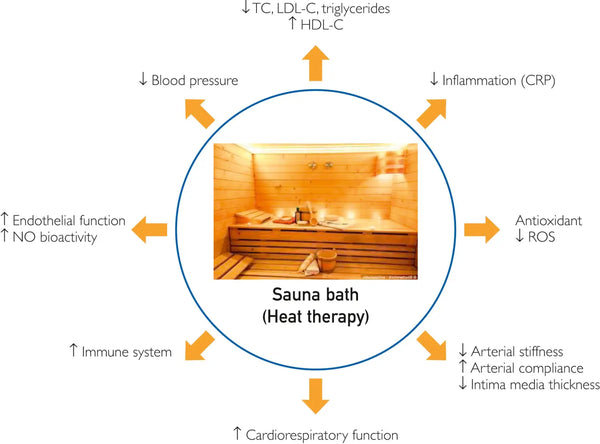
Image: Pleiotropic effects (proposed mechanistic pathways) of Finnish sauna baths
Source: Laukkanen, J. & Laukkanen, T. & Kunutsor, S. (2018). Cardiovascular and other health benefits of sauna bathing: a review of the evidence. Mayo Clinic Proceedings 93 (8): 1111–1121. Elsevier.
Sauna and the Immune System
Fever has functioned as a response to infections and sickness in both cold- and warm-blooded animals for millions of years. Sick animals have a higher chance of survival when they develop a fever.
Saunas have been used to treat influenza infection since at least 1957 if not earlier. On the other hand, suppressing a fever with antipyretic medication in humans increases the risk of influenza mortality.
Hyperthermia begins once the body temperature rises above what’s normal, which is around 37-37.5 °C. The minimal effective dose for stimulating the immune system appears to be a core temperature of 38 °C – a temperature that indicates mild fever.
Elevated body temperature strengthens immunity by promoting white blood cells, lymphocytes, neutrophils, interferons and enhancing the cytotoxicity of natural killer cells. Heat shock proteins (HSP) also inhibit viral replication.
- One study found that having a sauna session 2–3 or more than 4 times a week demonstrated a 27% and 41% reduction in respiratory diseases respectively compared to going to the sauna less than once a week. They also noted a 33% and 47% decreased risk of pneumonia, respectively.
- Episodes of the common cold have been seen to be cut in half among individuals who take the sauna several times a week compared to nothing. Thus it is plausible that sauna and other forms of hyperthermic conditioning may reduce the prevalence of colds, influenza, and other respiratory diseases.
- Human cell experiments have shown that hyperthermia enhances the antiviral effects of interferons by 3-10-fold. Sitting in the sauna for just 15 minutes has been seen to stimulate the immune system by increasing white blood cell count and lymphocytes.
- Inhaling warm air has also been shown to reduce the symptoms of the common cold. One randomized single-blind controlled trial found that patients with an acute cold infection experienced significantly fewer symptoms after 2 days of inhaling hot dry sauna air through their mouth compared to the dry outside air.
In summary, heat exposure is an easy and effective preventive health measure to fight disease during times of epidemics.
Sauna & physical exercise
- Better blood circulation and blood flow (via nitric oxide, NO) to skeletal muscle, which can reduce the rate of glycogen depletion and increase the efficiency of oxygen transport to muscles.
- Hyperthermic conditioning has been shown to reduce muscle glycogen use by 40-50% and lower lactate accumulation during exercise. It promotes physical endurance by increasing the heart’s stroke volume.
- 30-minute sauna sessions after working out 2 times per week for 3 weeks have been shown to increase the participants’ run until exhaustion by 32% compared to baseline.
- It can also enhance plasma volume by 7.1% and red blood cell count by 3.5%. This not only improves endurance but can also help with muscle growth and resistance training.
- Saunas are amazing for speeding up recovery from exercise and any kind of stress. It helps you lower inflammation created from working out, lowers muscle soreness (study on wrist extensors) after exercise.
Infrared heat room (sauna) therapy
Infrared heat rooms use infrared radiation which heats body tissues directly instead of air. The frequency of the radiation emitted by infrared heat rooms is 3–12 μm which falls under what is called far-infrared (FIR). Far-infrared has been found to have tissue-level effects particularly on the mitochondrial respiratory chain in the cell energy production process and the blood supply of tissues by dilating blood vessels and improving circulation.
In the past 15 years, many gyms and beauty salons have introduced infrared heat rooms alongside traditional saunas. An increasing number of people also install infrared heat rooms in their homes to enjoy the health benefits. In Western countries, infrared heat rooms are usually heated to approximately 40–50 degrees Celsius (104–122 Fahrenheit) at which point sweating begins in 15–20 minutes.
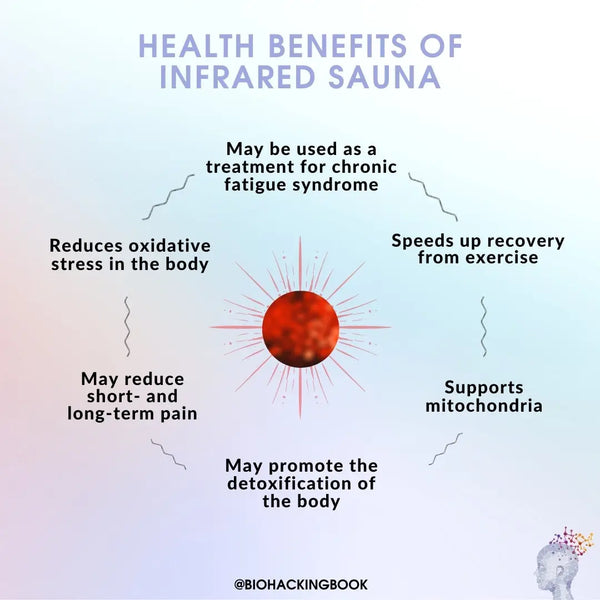
Waon therapy
In Japan, the properties of the infrared heat room are used for Waon therapy in which the sauna is heated to 60 degrees Celsius (140 Fahrenheit). Patients sit in the sauna for 15 minutes after which they are wrapped in heated blankets for 30 minutes more. Waon therapy is used particularly for patients suffering from heart failure to increase stroke volume, cardiac output, and ejection fraction. According to studies, Waon therapy significantly reduces cardiac deaths and issues caused by heart failure.
Other health benefits of the infrared heat room / sauna:
- Reduces oxidative stress in the body
- Speeds up recovery from exercise
- May reduce short- and long-term pain
- May promote the detoxification of the body through increased microcirculation and deep sweating caused by infrared radiation
- It may be used as a treatment for chronic fatigue syndrome as it can significantly ease the symptoms (Waon therapy)
- A 2018 meta-analysis showed that exposure to an infrared heat room at 60°C for 15 minutes, followed by a 30‐minute rest in a warm environment, five times a week for 2 to 4 weeks, was associated with a significant reduction in B‐type natriuretic peptide, cardiothoracic ratio, and an improvement in left ventricular ejection fraction.
Infrared heat room and detoxification
Human fat tissue (white fat) can store many toxins and man-made substances such as persistent organic pollutants (POPs). They can accumulate over the course of decades of exposure to the modern industrialized environment and have a low-grade inflammatory effect.
Fortunately, sweating is one of the primary detoxification methods in the human body. Studies find that heat-induced sweating can reduce POP levels by as much as 25–30% in adipose tissue and blood. Reducing POP levels in the body has been shown to improve IQ scores, neurocognitive functions, and work-related ability.
Sweating helps to eliminate heavy metals like arsenic, cadmium, lead, and mercury. Researchers have also found that sauna/infrared heat room helps to excrete phthalates, flame retardants, BPA, pesticides, and PCBs. It may even mitigate exposure to mold and mycotoxins.
The Hubbard protocol is one of the most known ones and it incorporates an infrared heat room (or sauna), niacin, and exercise to eliminate POPs. A key factor in the protocol is niacin (vitamin B3). In its common form (nicotinic acid), niacin causes a flush reaction caused by severe dilation of blood vessels. Its detoxification effect is based on rebound lipolysis. This means that the niacin releases a large volume of fatty acids and toxins from fat cells in a delayed manner, approximately 2–3 hours after consumption. Initially, niacin inhibits lipolysis. In liver cells, niacin promotes fat beta-oxidation and inhibits the synthesis of fatty acids (lipogenesis). Fat cells can store heavy metals so the process of rebound lipolysis assists in mobilizing heavy metals stored in fat tissue. This process may also benefit the treatment of fatty liver disease.
Elimination of heavy metals can then be conducted through sweating and/or use of chelation agents to bind the heavy metals through the digestive tract. Chelation therapy has a long history of use in clinical toxicology. Examples of chelation agents include alpha-lipoic acid, citric acid, malate, activated charcoal, cilantro, parsley, seaweeds, lactoferrin and pharmaceutical drugs such as DMSA, DMPS and EDTA.
Combining the protocol with exercise boosts circulation and by extension, the detoxification process. Conversely, an infrared heat room session improves microcirculation which in turn boosts the circulation of toxins in blood and their removal from the body through sweating.
As deep sweating is stronger in an infrared heat room session compared to traditional Finnish saunas. Therefore in comparison the use of an infrared heat room is likely to be more effective in combination with niacin for assisting detoxification through sweating.
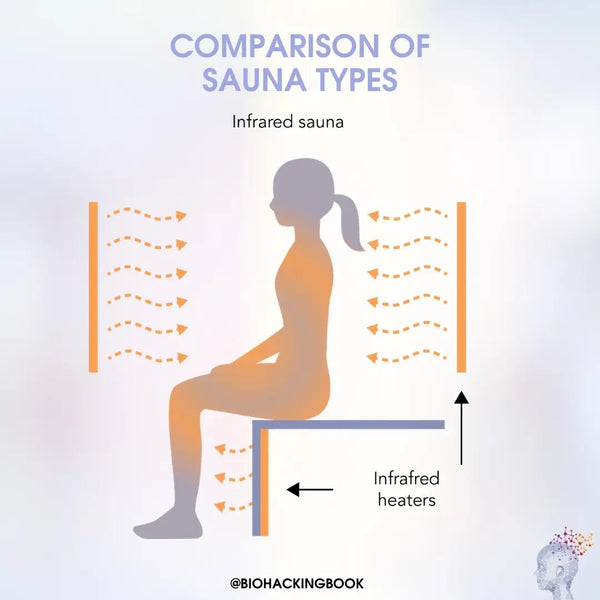
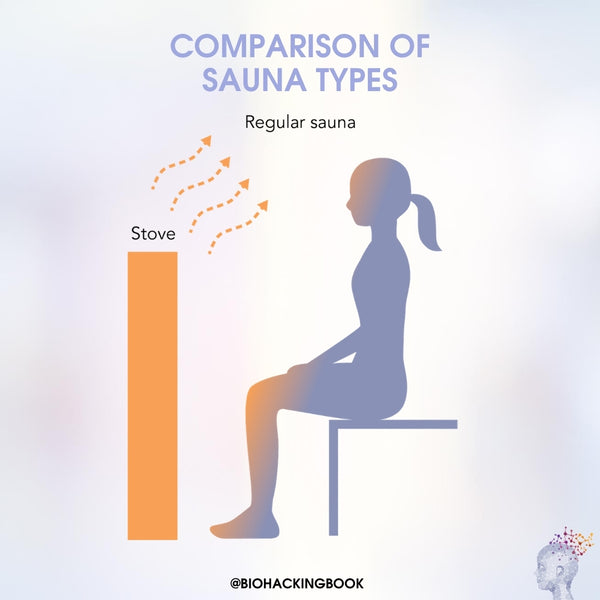
///





